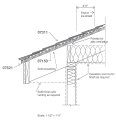
Asphalt/Glass Fiber Shingles at Eaves
The correct application of shingles at the eaves is critical because this is a vulnerable juncture that adjoins several roofing components.Materials
• Underlayment: 15-pound non-perforated asphalt-saturated felt.
• Eaves flashing: Ice and Water Shield - 30-pound eaves flashing or modified bitumen sheet.
• Shingles: Asphalt or glass fiber-reinforced roofing shingles.
• Nails: 11- or 12-gauge hot-dip galvanized roofing nails with deformed shanks.
• Drip edge: Minimum 28- gauge galvanized steel or other noncorrosive type of edging.
Execution
Underlayment: Apply underlayment over the entire deck area. On slopes less than 4:12, two layers of underlayment are required. In climates where the average January temperature is 30 degrees Fahrenheit or less, apply eaves flashing (Ice and Water Shield) a minimum of 36 inches from the perimeter edge up the slope.
Drip Edge: Apply drip edge over the underlayment with the appropriate fasteners every 8 inches on center. The drip edge should not extend more than 3 inches from the roof edge.
Shingles: Apply the starter course along the eaves prior to the installation of the first course of shingles. Starter strips can be fabricated by cutting the tabs off shingles or by applying the manufacturer’s starter shingles.
Apply successive courses in accordance with the manufacturer’s requirements for exposure and nailing patterns for the shingles specified. The first course should overhang the eave a minimum of ⅛ of an inch.
Apply the nails in locations required by the manufacturer. The nails should extend through the deck a minimum of ¾ of an inch.